50+ accounts payable statistics about AI, automation, & more
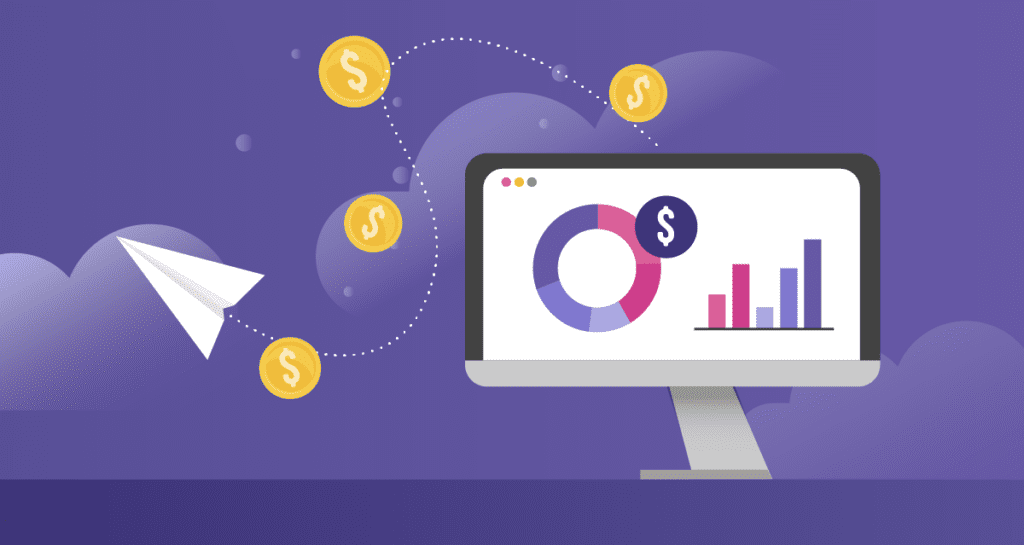
When it comes to accounts payable (AP), some things never change.
Processing invoices, balancing payment options, taking advantage of discounts, and improving speed and accuracy will always be core to AP.
But what does change is what “good” looks like and the tools and tricks AP teams and their leadership apply to consistently improve productivity.
That’s what this article is all about.
Here, we’ve collected a long list of important stats that indicate where the AP industry is with its most important targets, reveal where it’s going, and show how you can jump on board the most modern solutions to ride the wave to maximum efficiency.
The state of AP invoice payments
At the heart of AP is, well, payments!
It’s always interesting, and insightful, to know how most AP departments are issuing payments, why, and what it’s costing them.
Here’s what we know about all of the above, based on our report How & Why Companies Choose Payment Types, conducted in partnership with Treasury Webinars:
- Checks are still the head honcho when it comes to B2B payments. The majority (63%) of companies make at least 25% of payments by check, and another 34% make at least 50% of payments by check.
- Virtual/ghost cards are gaining traction among electronic payments. According to the companies surveyed, 61% said they make virtual and/or ghost card payments, 63% have internal programs to convert suppliers to using virtual or ghost cards, and 67% work with an AP automation provider to help convert suppliers to accepting virtual or ghost card payments.
If AP departments were able to choose any method for paying suppliers, here’s what they reported preferring:
- 36% credit card
- 30% check
- 24% ACH
- 5% no preference
- 4% virtual/ghost card
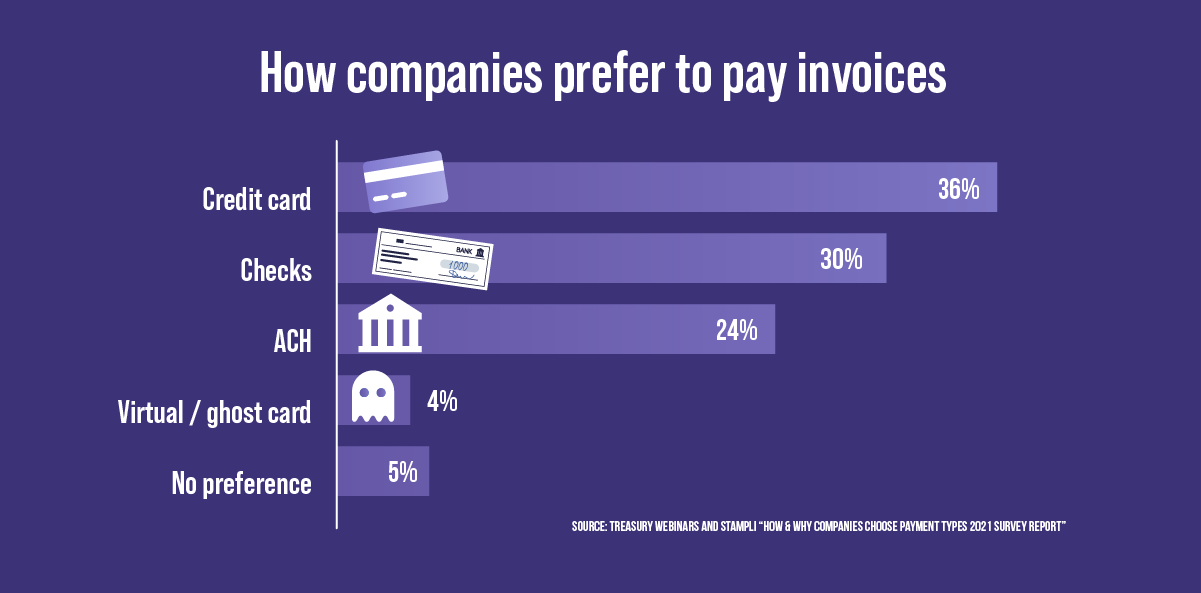
Isn’t it interesting how those preferences don’t line up with how most AP organizations are actually processing payments? Here’s the truth behind why these AP choices are made:
- 46% say processing costs are the reason for choosing certain payment types.
- 37% report it’s up to the preference of the supplier.
- 31% are simply sticking to the way they’ve always done it.
- 23% chalk it up to keeping things convenient for AP staff.
- 6% choose their methods for no discernible reason.
So, what’s the average cost for AP to process payments via the most popular methods? Here’s what we know:
- 89% of companies track how AP pays their suppliers.
- Around 75% also track what it costs to process the average invoice.
- The majority of businesses that pay via check say the cost to process a single invoice is $10 or less.
- Most businesses that pay via ACH report the cost to process an invoice at $5 or less.
- The majority of businesses that pay via card track invoice processing cost at $5 or under.
All the facts on invoice processing time
Each business’s invoice processing flow is full of unique complexities and eccentricities, but at the very basic level it usually consists of:
- Invoice capture, general ledger (GL) coding, and matching to supporting documents (like purchase orders and delivery receipts).
- Sending invoices to authorized approvers for their approval or rejection.
- Authorizing and submitting invoices for payment by sending them to your financial system.
- Setting up and processing payments.
- Archiving invoices and payment information in the GL for recordkeeping and future auditing purposes.
Clearly, there’s a lot to be done when it comes to wrapping up an invoice. How fast are AP teams doing all of this? Which step takes the most effort? How accurate are they? And critically, are they noticing any opportunities for improvement along the way?
Let’s dive into the most interesting AP metrics on the current state of invoice processing:
- Discounts captured: An Accounts Payable Performance Benchmark Report from the Institute of Financial Operations and Leadership (IFOL) found that, on average, AP departments capture just 58% of discounts that vendors make available to them (usually for early payment). Departments with high centralization and automation capture around 85% to 95% of discounts (impressive!).
- Invoices per FTE: The American Productivity and Quality Center (APQC) found in an accounts payable benchmarking report that the average AP FTE (full-time equivalent, representing a full-time worker) processes 10,853 invoices every year. Not bad! But in a fully automated system, that same FTE can process 23,333 invoices annually. In a completely manual process, that number is just 6,082 per year.
- Late payments: Close to half (40%) of AP teams say that their inability to validate invoices quickly causes them to pay late. This points directly to a need for a highly-integrable AP platform like Stampli, which doesn’t just quickly verify the authenticity and accuracy of invoices but keeps pushing them through the pipeline for fast and easy payment.
- Invoice error rate: According to APQC, manual invoicing processes typically lead to a 2% invoice error rate annually. With automation, that percentage can be chopped down to just 0.8% per year.
- Time to process an invoice: A study of AP professionals conducted by Probolsky Research and Stampli found that most organizations can process an invoice from capture through payment authorization — that’s most of the invoice processing workflow — in a week’s time or less.
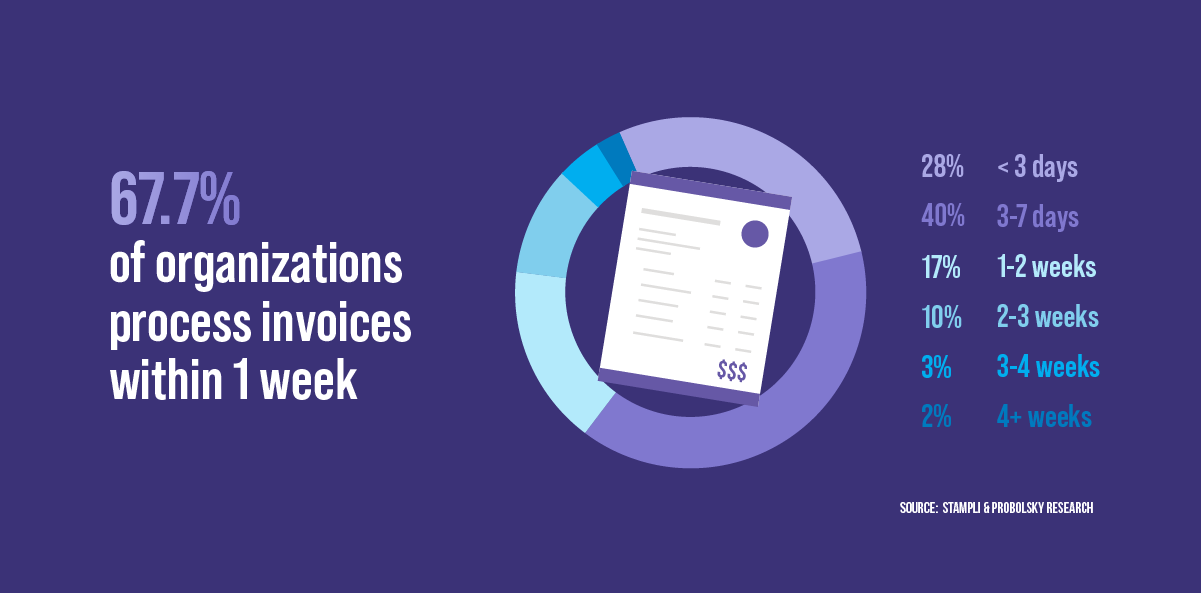
While a week to process an invoice may sound fine, a lot of departments know they can do it a lot faster — and, the proof is there — through automation and artificial intelligence. The Digitizing Accounts Payable and Receivable to Boost Efficiency and Enable Growth report from IDC uncovers exactly why this is the case:
- 75% of medium-sized businesses say invoices received are still primarily paper or email.
- 53% of all the work AP puts in is solely dedicated to manual invoice data entry and classification.
- The top 3 pain points in today’s AP departments are tracking down internal invoice approvals, manual invoice data entry, and classifying expenses.
- What is accounts payable looking for in accounting software? Intelligent invoice uploading and processing (37%), advanced AP process automation (34%), better user interfaces (30%), and online portals where vendors can submit invoices and keep their info up to date (25%).
AP invoice automation grows — fear remains
AP automation is a gamechanger, applying rules and artificial intelligence (more on that next!) to modern technology to assist AP pros folks in managing every element from invoice processing to reconciliation, payments, vendor management, and expenses. And not simply managing but getting it all done in a way that’s pretty painless, accurate, and time efficient.
With AP automation, businesses save money, and AP teams benefit from a morale boost and time to focus on more strategic thinking, which leads to better cash flow.
It’s no surprise that the percentage of AP teams adopting automation is steadily increasing.
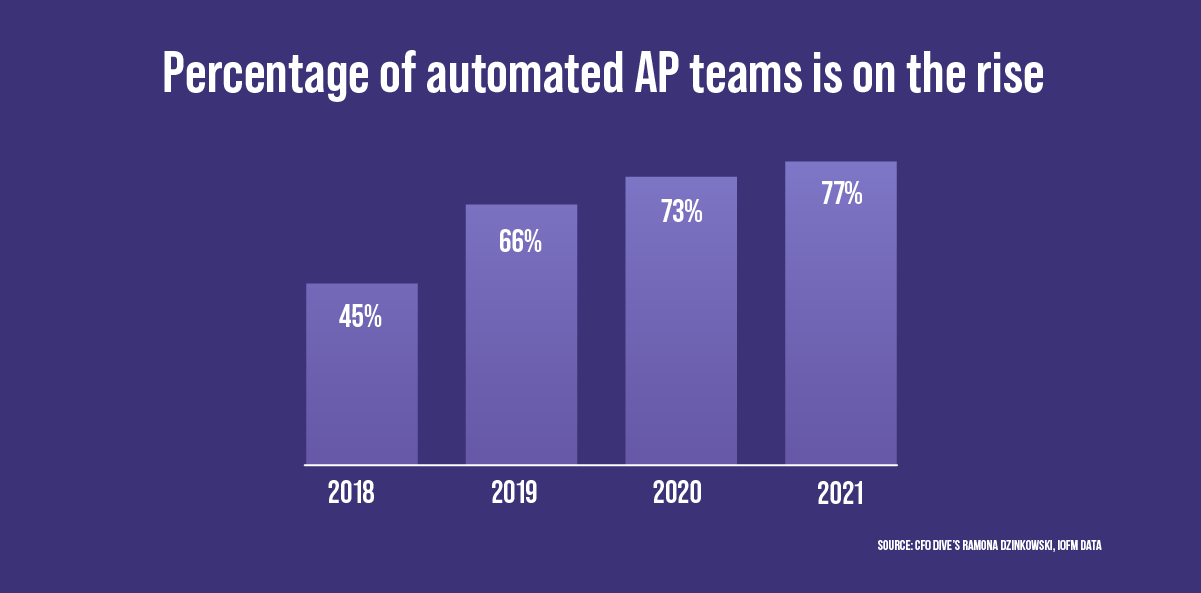
In fact, our research alongside Probolsky Research confirms that around 80% of accounts payable teams have some automated processes and elements.
But still, only 18% are fully automated!
Here’s what’s holding them back, per the report:
- 37% have cost concerns.
- 33% cite current staff knowledge and capabilities as a sticking point.
- 33% blame concerns over data security.
- 28% wonder about the complexity and cost associated with ERP integration.
- 22% chalk it up to resistance from staff.
- 22% have a lack of internal tech experts.
- 22% are worried about their complex customization needs.
- 15% are simply unwilling to switch it up right now.
- 12% actually want to hold on to physical payment records.
- 12% say it won’t work because their vendors don’t accept digital payments.
All that aside, AP leaders and workforces are still fully aware of all the upsides of AP automation telling us in our survey that they see the biggest benefits as:
- 54% are excited about reducing errors, missed payments, and duplicate payments.
- 54% consider faster approvals and payments a big benefit.
- 52% see the value in improving visibility into invoice statuses.
- 48% are excited about better financial reporting and forecasting.
- 40% look forward to simply reducing the labor associated with AP.
- 40% believe automation will give more control over approval flows.
- 37% see the opportunity for improving supplier relationships.
- 37% appreciate the environmental aspect of reducing paper invoices.
- 35% are interested in having more control over cash flow.
- 34% see value in improved regulation compliance.
- 27% see the benefit of increased fraud mitigation.
Accounts payable statistics on AI adoption
To build on AP automation, artificial intelligence (AI) is a key element in the AP tech that enables powerful automation.
AI is critical in AP—and plenty of other departments—to helping humans more quickly and accurately complete simple and complex repetitive tasks, such as processing invoices.
Let’s explore where AI adoption stands in accounts payable departments and technology, why it’s needed, and how it’s currently perceived by the people who work with it day in and day out.
The Stampli and Probolsky Research study found that the majority of people across AP are interested in adopting AI into their processes:
- 89% of CFOs, VPs, directors, and managers in the finance space are either very or somewhat interested in AI for AP.
- 68% of folks on AP teams are also very or somewhat interested in using AI for AP.
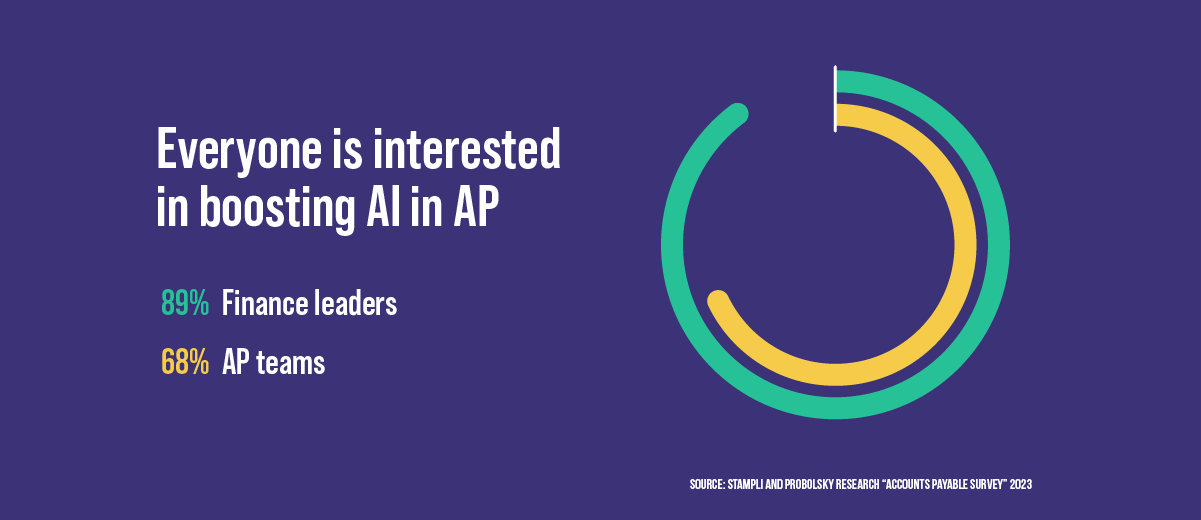
What is it that’s keeping businesses and teams from going all in on AI? The same study uncovered their thoughtful and valid concerns, including:
- 46% worry about privacy and security of data.
- 41% are concerned about the lack of human oversight.
- 30% fret over AI inventing false or inaccurate information.
- 25% are anxious about job loss.
- 25% worry about the technical learning curve.
- 25% are concerned about dependence on AI vendors.
That said, the same group of people also recognized the many business benefits that can come along with using AI in AP:
- 51% realize AI can improve accuracy.
- 46% believe AI will improve processing speeds.
- 40% look forward to improved fraud detection.
- 38% believe AI can achieve cost savings.
- 38% think AI will improve financial system efficiency.
- 37% look forward to AI refocusing humans on more valuable tasks.
Which advanced, AI-powered features are defining modern accounts payable invoice automation (APIA) tools? A market guide on AP IA and automation from Gartner found:
- 10% of APIA software includes NLP features. Widely-adopted, optical character recognition (OCR) tech is enhanced with help from natural language processing (NLP) to digitize documents with high success rates and minimal training.
Stampli, along with our AI Billy the Bot ™, is one of the few to deploy NPL to quickly extract data from, understand, and classify invoices so they can then be sent smoothly to your ERP or accounting system. - 35% of APIA tools have automated, AI-driven invoice coding. This feature enables trained machine learning (ML) algorithms to help AP staff with accurate, consistent coding suggestions.
Stampli makes it easy for AP pros to automate account invoice coding to reduce errors and move more quickly than ever as invoice numbers and complexity rise. - 55% of APIA platforms use AI for fraud and duplicate detection. Modern AI engines can identify potential duplicate invoices based on content and flag unusual amounts for review before payment.
Get to know your vendors, hire trustworthy employees, and ensure you’re using smart software with strong controls that automatically recognize fraudulent and duplicate invoices. - 15% of APIA tools feature AI-powered workflows. With smart workflows, AI learns where to route accurate invoices and where to send those with errors, minimizing the reviews and touches that increase processing time and inaccuracies.
Again, Stampli’s Billy AI enables dynamic workflows by learning and observing during the invoice capture process to improve and adapt your accounts payable process as needed — even making suggestions when it spots a better way to do things.
Stack up to these accounts payable metrics with Stampli
Stampli is not only an AP automation tool with AI at its core that doesn’t make you rethink your entire ERP and AP workflow setup — it’s also a recognized leader in accounts payable, payment processing, and invoicing and billing.
In other words, it’s an easy-to-integrate and just as easy-to-use platform for boosting your numbers in invoice processing, payments, AP automation, and AI adoption.
Want to quickly see the positive impact of smart and modern AP automation on your bottom line? We thought so — which is why we’ve optimized our no-code, non-disruptive implementation to take just weeks, not months.